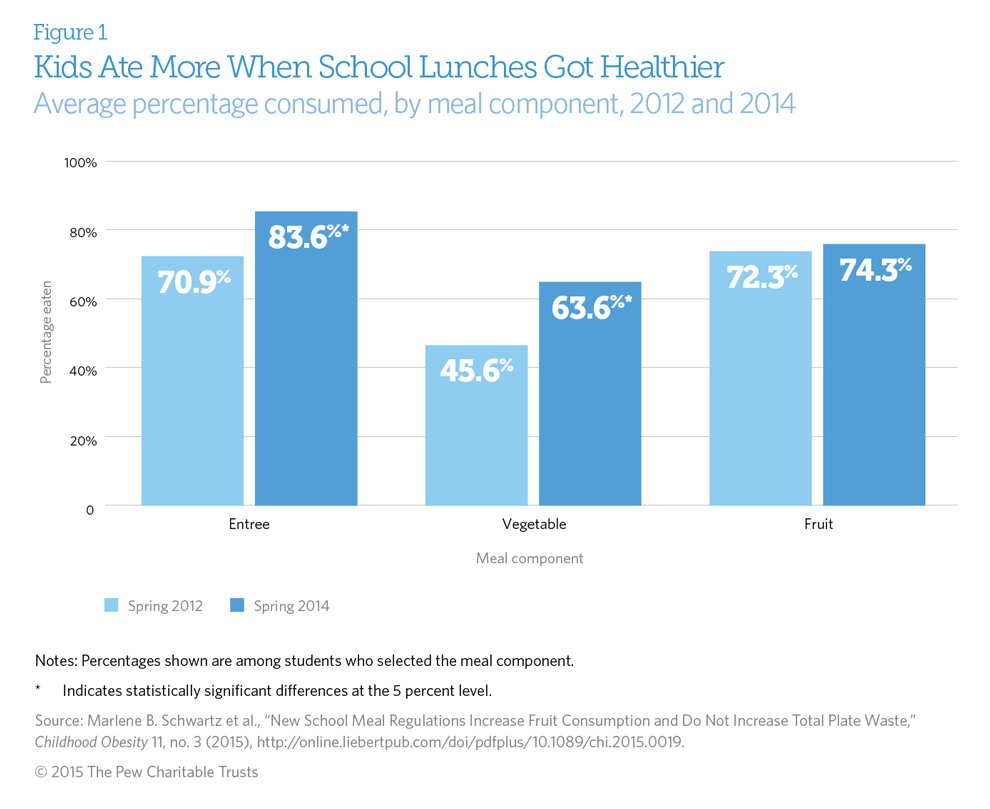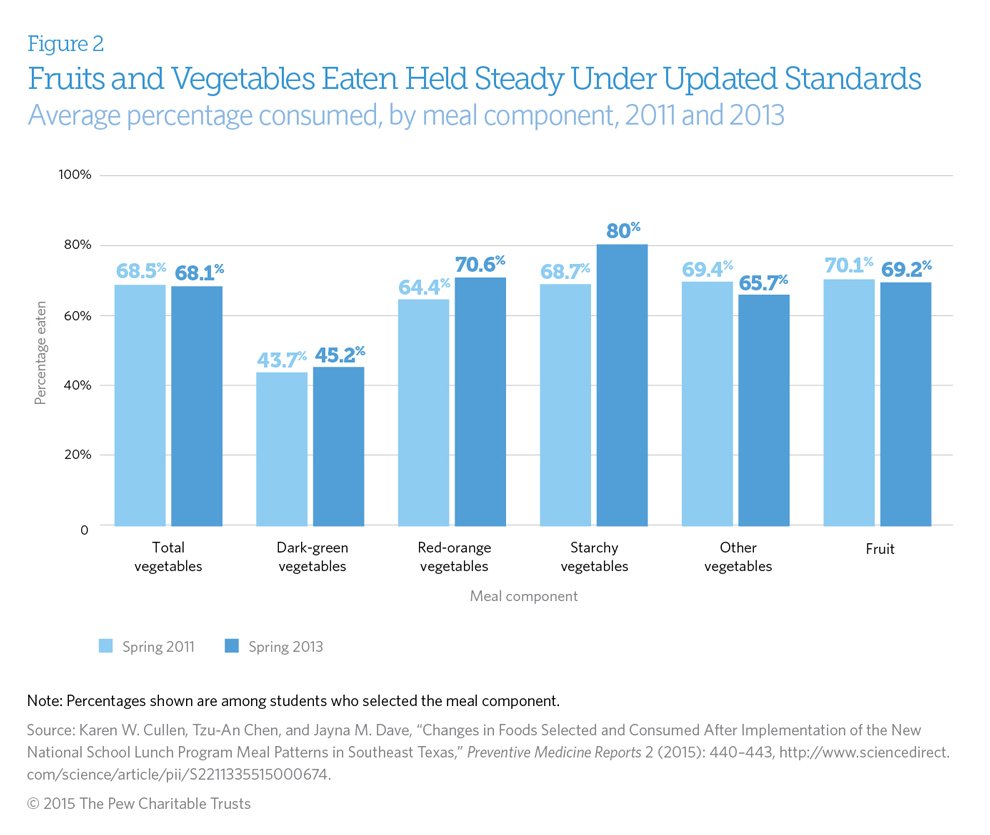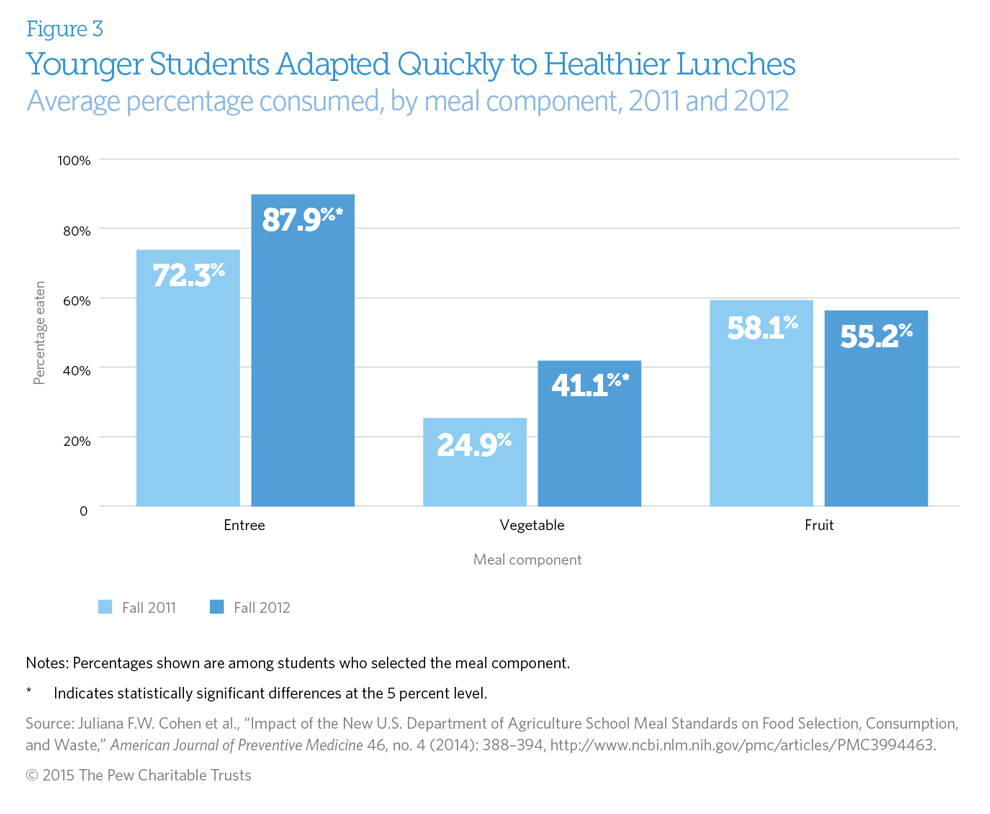Healthy School Lunches Improve Kids’ Habits
Research shows that strong nutrition standards work
Schools can serve healthy lunches, but whether kids will eat them is a question that has been asked often since the 2012-13 school year, when districts across the United States raised the nutritional quality of meals to meet updated national standards.
Multiple studies comparing students’ eating habits before and after these changes show that the answer is clearly yes. Among the four studies that tracked the largest numbers of children, three measured the amount of food students selected and calculated the percentage eaten and discarded, and the fourth evaluated changes in the nutritional quality of the lunches kids chose.
Middle schoolers ate more, wasted less
Researchers from the Rudd Center for Food Policy and Obesity weighed and photographed lunches served to children at 12 Connecticut schools in spring 2012, 2013, and 2014. Compared with 2012, the amount of their entrees that children ate increased by nearly 13 percentage points, and of their vegetables, 18 percentage points by the last year of the study. (See Figure 1.) Food waste declined as a result.
The researchers also found that greater variety led to healthier choices. Each additional fruit option offered was associated with a 9.3 percent increase in fruit servings selected by students.1

Greater variety led to healthier choices. Each additional fruit option offered was associated with a 9.3 percent increase in the number of students taking a fruit serving.
Texas students ate more fruit, made more varied vegetable choices
Researchers with the Baylor College of Medicine and Texas Children’s Hospital observed and recorded meals at eight elementary schools in southeast Texas before and after the 2012 updates.
In 2013, more students took whole fruit with their lunches—76 percent, compared with 58 percent in 2011—and they ate about 2 tablespoons more fruit (including 100 percent juice). Kids who chose red-orange vegetables with their meals nearly doubled their consumption of these foods in 2013, eating almost a quarter cup, compared with about an eighth of a cup in 2011.2
Overall, the percentage of fruits and vegetables that students discarded did not change. (See Figure 2.)

Kids ate more of their entrees and vegetables
The Harvard School of Public Health investigated the transition to healthier school lunches among students in grades 1 through 8 in four schools in Massachusetts. Researchers recorded and weighed students’ meal selections and the food discarded from each tray in the fall of 2011 and again one year later.
In 2012, more children took a serving of fruit, and they ate larger shares of entree and vegetable servings compared with the previous year.3 (See Figure 3.)

Among older students, meal nutrition improved with no decline in participation rates
University of Washington researchers analyzed more than 1.7 million school lunches selected by students in three middle schools and three high schools near Seattle over a 31-month period.
In 2014, students chose lunches containing 29 percent more of key nutrients and 13 percent fewer calories per gram than meals selected in 2011. The researchers concluded that the inclusion of more and varied fruit and vegetable choices on school menus was the main reason that the nutritional quality of children’s lunches improved.
The schools saw no significant change in lunch participation rates as students encountered healthier options in cafeterias.4
Conclusion
Teaching children the importance of a balanced diet requires consistent, long-term efforts, but considerable evidence shows that schools have—and are seizing—the opportunity to help young Americans develop healthy eating habits. Although areas such as menu variety and food waste still have room to improve, these studies demonstrate that kids are accepting and benefiting from school lunches that meet today’s strong national standards.
Endnotes
- Marlene B. Schwartz et al., “New School Meal Regulations Increase Fruit Consumption and Do Not Increase Total Plate Waste,” Childhood Obesity 11, no. 3 (2015), http://online.liebertpub.com/doi/pdfplus/10.1089/chi.2015.0019.
- Karen W. Cullen, Tzu-An Chen, and Jayna M. Dave, “Changes in Foods Selected and Consumed After Implementation of the New National School Lunch Program Meal Patterns in Southeast Texas,” Preventive Medicine Reports 2 (2015): 440–43, http://www.sciencedirect.com/science/article/pii/S2211335515000674.
- Juliana F.W. Cohen et al., “Impact of the New U.S. Department of Agriculture School Meal Standards on Food Selection, Consumption, and Waste,” American Journal of Preventive Medicine 46, no. 4 (2014): 388–94, http://www.ncbi.nlm.nih.gov/pmc/articles/PMC3994463.
- Donna B. Johnson et al., “Effect of the Healthy Hunger-Free Kids Act on the Nutritional Quality of Meals Selected by Students and School Lunch Participation Rates,” JAMA Pediatrics 170, no. 1 (2016), http://archpedi.jamanetwork.com/article.aspx?articleid=2478057.






